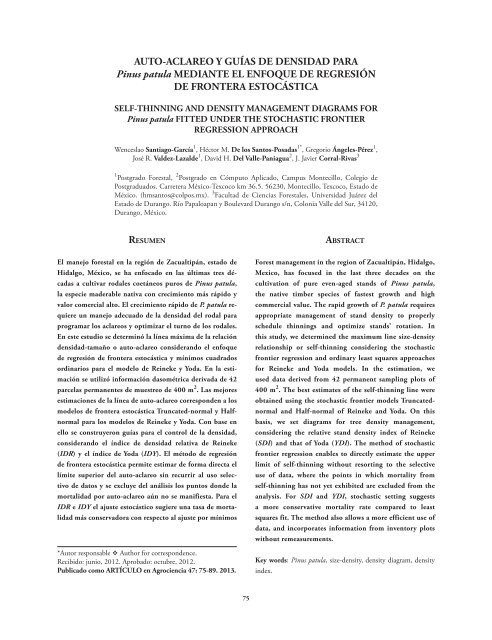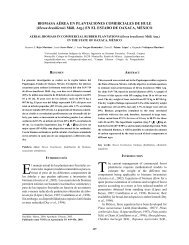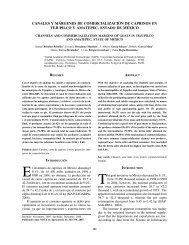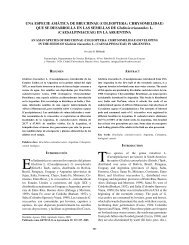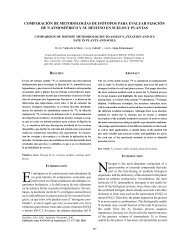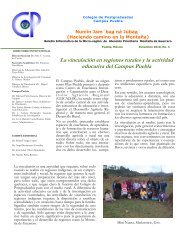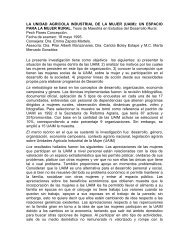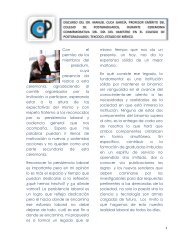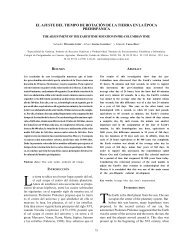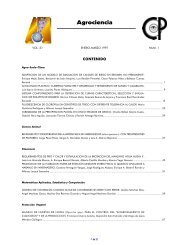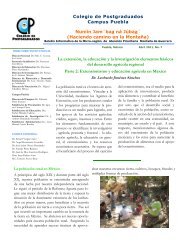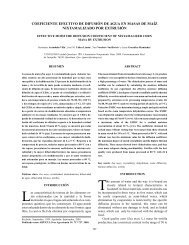AUTO-ACLAREO Y GUÍAS DE DENSIDAD PARA Pinus patula ...
AUTO-ACLAREO Y GUÍAS DE DENSIDAD PARA Pinus patula ...
AUTO-ACLAREO Y GUÍAS DE DENSIDAD PARA Pinus patula ...
Create successful ePaper yourself
Turn your PDF publications into a flip-book with our unique Google optimized e-Paper software.
<strong>AUTO</strong>-<strong>ACLAREO</strong> Y <strong>GUÍAS</strong> <strong>DE</strong> <strong>DE</strong>NSIDAD <strong>PARA</strong><br />
<strong>Pinus</strong> <strong>patula</strong> MEDIANTE EL ENFOQUE <strong>DE</strong> REGRESIÓN<br />
<strong>DE</strong> FRONTERA ESTOCÁSTICA<br />
SELF-THINNING AND <strong>DE</strong>NSITY MANAGEMENT DIAGRAMS FOR<br />
<strong>Pinus</strong> <strong>patula</strong> FITTED UN<strong>DE</strong>R THE STOCHASTIC FRONTIER<br />
REGRESSION APPROACH<br />
Wenceslao Santiago-García 1 , Héctor M. De los Santos-Posadas 1* , Gregorio Ángeles-Pérez 1 ,<br />
José R. Valdez-Lazalde 1 , David H. Del Valle-Paniagua 2 , J. Javier Corral-Rivas 3<br />
1 Postgrado Forestal, 2 Postgrado en Cómputo Aplicado, Campus Montecillo, Colegio de<br />
Postgraduados. Carretera México-Texcoco km 36.5. 56230, Montecillo, Texcoco, Estado de<br />
México. (hmsantos@colpos.mx). 3 Facultad de Ciencias Forestales, Universidad Juárez del<br />
Estado de Durango. Río Papaloapan y Boulevard Durango s/n, Colonia Valle del Sur, 34120,<br />
Durango, México.<br />
Resumen<br />
El manejo forestal en la región de Zacualtipán, estado de<br />
Hidalgo, México, se ha enfocado en las últimas tres dé-<br />
cadas a cultivar rodales coetáneos puros de <strong>Pinus</strong> <strong>patula</strong>,<br />
la especie maderable nativa con crecimiento más rápido y<br />
valor comercial alto. El crecimiento rápido de P. <strong>patula</strong> re-<br />
quiere un manejo adecuado de la densidad del rodal para<br />
programar los aclareos y optimizar el turno de los rodales.<br />
En este estudio se determinó la línea máxima de la relación<br />
densidad-tamaño o auto-aclareo considerando el enfoque<br />
de regresión de frontera estocástica y mínimos cuadrados<br />
ordinarios para el modelo de Reineke y Yoda. En la esti-<br />
mación se utilizó información dasométrica derivada de 42<br />
parcelas permanentes de muestreo de 400 m 2 . Las mejores<br />
estimaciones de la línea de auto-aclareo corresponden a los<br />
modelos de frontera estocástica Truncated-normal y Half-<br />
normal para los modelos de Reineke y Yoda. Con base en<br />
ello se construyeron guías para el control de la densidad,<br />
considerando el índice de densidad relativa de Reineke<br />
(IDR) y el índice de Yoda (IDY). El método de regresión<br />
de frontera estocástica permite estimar de forma directa el<br />
límite superior del auto-aclareo sin recurrir al uso selec-<br />
tivo de datos y se excluye del análisis los puntos donde la<br />
mortalidad por auto-aclareo aún no se manifiesta. Para el<br />
IDR e IDY el ajuste estocástico sugiere una tasa de morta-<br />
lidad más conservadora con respecto al ajuste por mínimos<br />
*Autor responsable v Author for correspondence.<br />
Recibido: junio, 2012. Aprobado: octubre, 2012.<br />
Publicado como ARTÍCULO en Agrociencia 47: 75-89. 2013.<br />
75<br />
AbstRAct<br />
Forest management in the region of Zacualtipán, Hidalgo,<br />
Mexico, has focused in the last three decades on the<br />
cultivation of pure even-aged stands of <strong>Pinus</strong> <strong>patula</strong>,<br />
the native timber species of fastest growth and high<br />
commercial value. The rapid growth of P. <strong>patula</strong> requires<br />
appropriate management of stand density to properly<br />
schedule thinnings and optimize stands’ rotation. In<br />
this study, we determined the maximum line size-density<br />
relationship or self-thinning considering the stochastic<br />
frontier regression and ordinary least squares approaches<br />
for Reineke and Yoda models. In the estimation, we<br />
used data derived from 42 permanent sampling plots of<br />
400 m 2 . The best estimates of the self-thinning line were<br />
obtained using the stochastic frontier models Truncated-<br />
normal and Half-normal of Reineke and Yoda. On this<br />
basis, we set diagrams for tree density management,<br />
considering the relative stand density index of Reineke<br />
(SDI) and that of Yoda (YDI). The method of stochastic<br />
frontier regression enables to directly estimate the upper<br />
limit of self-thinning without resorting to the selective<br />
use of data, where the points in which mortality from<br />
self-thinning has not yet exhibited are excluded from the<br />
analysis. For SDI and YDI, stochastic setting suggests<br />
a more conservative mortality rate compared to least<br />
squares fit. The method also allows a more efficient use of<br />
data, and incorporates information from inventory plots<br />
without remeasurements.<br />
Key words: <strong>Pinus</strong> <strong>patula</strong>, size-density, density diagram, density<br />
index.
AGROCIENCIA, 1 de enero - 15 de febrero, 2013<br />
cuadrados. El método permite además el uso más eficiente<br />
de los datos e incorporar información de parcelas de inven-<br />
tario sin remediciones.<br />
Palabras clave: <strong>Pinus</strong> <strong>patula</strong>, densidad-tamaño, diagrama de<br />
densidad, índice de densidad.<br />
76<br />
IntRoduccIón<br />
El control de la densidad del rodal es clave<br />
en el manejo forestal. Después de la calidad<br />
del sitio, se considera el segundo factor en<br />
importancia para determinar la productividad de<br />
un sitio forestal y puede ser manipulada con relativa<br />
facilidad por el administrador forestal mediante<br />
aclareos (Daniel et al., 1979). El aclareo es una<br />
intervención directa al rodal que libera espacio de<br />
crecimiento al eliminar ciertos árboles y colocar a<br />
los individuos remanentes en una posición competitiva<br />
ventajosa, redistribuyendo el potencial de<br />
crecimiento del rodal (Smith et al., 1997). Como<br />
práctica silvicultural, el aclareo requiere una evaluación<br />
cuantitativa de la densidad para conocer<br />
el nivel de competencia intraespecífica y con ello<br />
tomar decisiones sobre la necesidad e intensidad<br />
del aclareo (Husch et al., 1982; Torres y Magaña,<br />
2001).<br />
En silvicultura las medidas de densidad relativa<br />
son de gran interés para evaluar el grado de densidad<br />
de un rodal. La medida de densidad relativa tradicional<br />
para la construcción de diagramas o guías de<br />
densidad es el índice de densidad de Reineke (IDR).<br />
El IDR está basado en la relación densidad-tamaño<br />
que existe entre el número de árboles por hectárea<br />
(NA) de un rodal y su diámetro medio cuadrático<br />
(Dq). Expresada en escala logarítmica base 10, esta<br />
relación tendría una pendiente universal de 1.605<br />
(Reineke, 1933; Pretzsch, 2009). Otra medida usada<br />
para evaluar densidad es el índice de Yoda (IDY)<br />
basado en la ley del auto-aclareo (relación máxima<br />
densidad-tamaño) o ley de los 3/2. En escala logarítmica<br />
natural, la relación entre el número de plantas<br />
por unidad de área y su biomasa promedio debería<br />
mantener una relación lineal con una pendiente<br />
universal de 1.5 (Yoda et al., 1963; Pretzsch, 2009).<br />
En dasonomía se utiliza el volumen promedio de los<br />
árboles y el número de árboles por unidad de superficie<br />
para evaluar la densidad de un rodal (Drew y<br />
Flewelling, 1979).<br />
VOLUMEN 47, NÚMERO 1<br />
IntRoductIon<br />
Controlling stand density is fundamental<br />
in forest management. After site quality,<br />
stand density is considered the second<br />
most important factor in determining forest site<br />
productivity. It may be modified by foresters through<br />
thinning to achieve a desired future stand condition<br />
(Daniel et al., 1979). Thinning is a direct intervention<br />
in the stand that releases space for growth by removing<br />
some trees and placing the remaining individuals in<br />
a competitive favorable position, redistributing stand<br />
growth potential (Smith et al., 1997). As silvicultural<br />
practice, thinning requires a quantitative assessment<br />
of tree density to determine the level of intraspecific<br />
competition and thus make decisions about the need<br />
and intensity of thinning (Husch et al., 1982, Torres<br />
and Magaña, 2001).<br />
In forestry, relative density measurements<br />
are of great interest to assess the degree of stand<br />
density. The traditional measure of relative density<br />
for developing density diagrams or guides is the<br />
Reineke’s stand density index (SDI). The SDI is<br />
based on the size-density relationship between the<br />
number of trees per hectare (NA) of a stand and<br />
its quadratic mean diameter (Dq). Expressed in<br />
base 10 logarithmic scale, this relationship should<br />
have a universal slope of 1.605 (Reineke, 1933;<br />
Pretzsch, 2009). Another measure used to evaluate<br />
the density is Yoda index (YDI), based on the selfthinning<br />
law (maximum size-density relationship)<br />
or law of 3/2. In natural logarithmic scale, the<br />
relationship between the number of plants per unit<br />
area and average biomass should maintain a linear<br />
relationship with a universal slope of 1.5 (Yoda et<br />
al., 1963; Pretzsch, 2009). In forestry, the average<br />
volume of trees and the number of trees per unit<br />
area are used to assess the density of a stand (Drew<br />
and Flewelling, 1979).<br />
A guide or density management diagram is a<br />
graphical model that allows us to track changes in<br />
the density of even-aged stands considering sizedensity<br />
relationships (Torres and Magaña, 2001).<br />
These forestry tools reflect fundamental relationships<br />
including the size of the trees, the total number of<br />
living individuals, occupation and self-thinning<br />
(Vacchiano et al., 2008). Their application allows us<br />
to properly program the thinning of a stand when<br />
considering the fact that trees die from self-thinning
<strong>AUTO</strong>-<strong>ACLAREO</strong> Y <strong>GUÍAS</strong> <strong>DE</strong> <strong>DE</strong>NSIDAD <strong>PARA</strong> <strong>Pinus</strong> <strong>patula</strong> MEDIANTE EL ENFOQUE <strong>DE</strong> REGRESIÓN <strong>DE</strong> FRONTERA ESTOCÁSTICA<br />
Una guía o diagrama de densidad es un modelo<br />
gráfico que permite dar seguimiento a los<br />
cambios en la densidad de los rodales coetáneos<br />
considerando relaciones de densidad-tamaño (Torres<br />
y Magaña, 2001). Estas herramientas silvícolas<br />
reflejan relaciones fundamentales que incluyen el<br />
tamaño de los árboles, el número total de individuos<br />
vivos, la ocupación y el auto-aclareo (Vacchiano<br />
et al., 2008). Su aplicación permite programar<br />
adecuadamente los aclareos de un rodal al<br />
considerar que los árboles mueren por auto-aclareo<br />
cuando están cerca de la densidad máxima para<br />
un tamaño de árbol determinado (Smith et al.,<br />
1997).<br />
Los métodos usados para ajustar la línea de auto-aclareo<br />
así como los datos usados en el ajuste<br />
son controversiales (Bi et al., 2000; Zhang et al.,<br />
2005). El método más común para estimar la línea<br />
máxima de la relación densidad-tamaño consiste<br />
en relacionar linealmente la densidad del rodal y<br />
el tamaño del arbolado mediante mínimos cuadrados<br />
ordinarios (MCO) y los datos seleccionados de<br />
rodales coetáneos de máxima densidad (en máxima<br />
competencia). Este enfoque es subjetivo y resulta<br />
en una estimación de un máximo medio en contraposición<br />
a un máximo absoluto de la relación<br />
densidad-tamaño.<br />
La técnica econométrica modelo de regresión<br />
de frontera estocástica (RFE; Aigner et al., 1977)<br />
fue usada por Bi et al. (2000), Bi (2001, 2004) y<br />
Zhang et al. (2005) para estimar la línea del autoaclareo<br />
en rodales coetáneos y puros de pino. Este<br />
método usa todos los datos disponibles en la estimación<br />
funcional de los coeficientes, excluyendo<br />
la necesidad de marcar arbitrariamente particiones<br />
en los datos, lo cual elimina la subjetividad y provee<br />
una estimación eficiente del límite superior del<br />
auto-aclareo.<br />
Los objetivos de este estudio fueron: 1) estimar<br />
la línea del auto-aclareo en rodales coetáneos<br />
de <strong>Pinus</strong> <strong>patula</strong> Schiede ex Schlechtendal &<br />
Chamisso mediante la función de frontera estocástica<br />
y el enfoque de mínimos cuadrados ordinarios<br />
para los modelos de Reineke y de Yoda,<br />
2) comparar las estimaciones de las líneas del autoaclareo<br />
obtenidas, y 3) generar diagramas para el<br />
manejo de la densidad de los rodales considerados<br />
a partir de la mejor estimación de la línea del<br />
auto-aclareo.<br />
when they are near the maximum density for a given<br />
tree size (Smith et al., 1997).<br />
The methods used to fit the self-thinning line<br />
and data used in the fitting are controversial (Bi et<br />
al., 2000, Zhang et al., 2005). The most common<br />
method for estimating the maximum line of the<br />
size-density relationship is to relate linearly stand<br />
density and the size of trees through ordinary<br />
least squares methods (OLS) and the data from<br />
even-aged stands of maximum density (maximum<br />
competition). This approach is subjective and<br />
results in an estimate of a half maximum, as<br />
opposed to an absolute maximum of the sizedensity<br />
relationship.<br />
The econometric technique stochastic frontier<br />
regression (SFR; Aigner et al., 1977) was employed<br />
by Bi et al. (2000), Bi (2001, 2004) and Zhang et<br />
al. (2005) to estimate the line of self-thinning in<br />
even-aged and pure pine stands. This method uses<br />
all available data for the functional estimation of<br />
coefficients, excluding the need to mark arbitrarily<br />
partitioned data, which eliminates subjectivity and<br />
provides an efficient estimate of the upper limit of<br />
self-thinning.<br />
The objectives of this study were 1) to estimate<br />
the line of self-thinning in even-aged stands of <strong>Pinus</strong><br />
<strong>patula</strong> Schiede ex Schlechtendal & Chamisso by<br />
using the stochastic frontier function and ordinary<br />
least squares approach for models of Reineke and<br />
Yoda; 2) to compare estimates of the self-thinning<br />
lines obtained; and 3) develop diagrams for density<br />
management of the stands based on the best estimates<br />
of the self-thinning line.<br />
mAteRIAls And methods<br />
Study area and dasometric data<br />
The data used in this study come from three measurements<br />
made periodically in 42 permanent sampling square-shaped<br />
plots, of 400 m 2 , located in pure and even-aged stands of P.<br />
<strong>patula</strong> in Ejido La Mojonera, southeast of the municipality of<br />
Zacualtipán de Ángeles, in the state of Hidalgo, Mexico. We<br />
used the number of trees (NA), total height (A) and diameter at<br />
breast height (D) of all living trees within each plot to estimate<br />
the following stand state variables: basal area (AB, m 2 ha 1 ),<br />
number of trees (NA ha 1 ), quadratic mean diameter (Dq, cm):<br />
Dq<br />
40000 AB<br />
= ×<br />
π NA<br />
and volume (V, m 3 ha 1 ). Considering<br />
SANTIAGO-GARCÍA et al.<br />
77
AGROCIENCIA, 1 de enero - 15 de febrero, 2013<br />
78<br />
mAteRIAles y métodos<br />
Área de estudio y datos dasométricos<br />
Los datos usados en este estudio provienen de tres medicio-<br />
nes realizadas periódicamente en 42 parcelas permanentes de<br />
muestreo de forma cuadrada de 400 m 2 , localizadas en rodales<br />
puros y coetáneos de P. <strong>patula</strong> en el ejido La Mojonera, al su-<br />
reste del municipio de Zacualtipán de Ángeles, en el estado de<br />
Hidalgo, México. Se usó el número de árboles (NA), la altura<br />
total (A) y el diámetro normal (D) de todos los árboles vivos<br />
dentro de cada parcela para estimar las siguientes variables de es-<br />
tado del rodal: área basal (AB, m 2 ha 1 ), número de árboles (NA<br />
ha 1 ), diámetro cuadrático (Dq, cm): Dq<br />
VOLUMEN 47, NÚMERO 1<br />
40000 AB<br />
= ×<br />
π NA<br />
volumen (V, m 3 ha 1 ). Considerando el volumen y el número de<br />
árboles por hectárea, se obtuvo el volumen promedio por árbol<br />
(Vp, m 3 ): VpV/NA. En la relación limitante densidad-tamaño<br />
o auto-aclareo se emplearon el NA vs. Dq y el Vp vs. NA para el<br />
modelo de Reineke y el de Yoda.<br />
Modelos de mínimos cuadrados ordinarios (MCO)<br />
El número de árboles por hectárea para una densidad com-<br />
pleta varía dependiendo del diámetro promedio del rodal. Para<br />
determinar la densidad del rodal, es necesario tener una curva<br />
que muestre el número de árboles por hectárea para todos los<br />
diámetros promedio. Esta curva puede ser representada por la<br />
Ecuación 1(Reineke, 1933; Pretzsch, 2009):<br />
NADq (1)<br />
Al linealizar (1) se obtiene el modelo de Reineke para estimar la<br />
línea del auto-aclareo:<br />
ln(NA)ln(Dq) (2)<br />
( )<br />
εiid N 0 σε 2<br />
,<br />
El modelo de auto-aclareo de Yoda corresponde al modelo lineal<br />
de la forma (Yoda et al., 1963; Bi et al., 2000; Montero et al.,<br />
2007):<br />
ln(Vp)ln(NA) (3)<br />
( )<br />
εiid N 0 σε 2<br />
,<br />
donde NA es el número de árboles por hectárea, Dq es el diá-<br />
metro cuadrático por hectárea, Vp es el volumen promedio por<br />
y<br />
the volume and number of trees per hectare, we obtained the<br />
average volume per tree (Vp, m 3 ): VpV/NA. In the limiting<br />
size-density relationship or self-thinning we used NA vs. Dq and<br />
Vp vs. NA for both the Reineke and Yoda models.<br />
Ordinary least square models (OLS)<br />
The number of trees per hectare for full density varies with<br />
the mean stand diameter. To determine the stand density, it is<br />
necessary to develop a curve showing the number of trees per<br />
hectare for all mean diameters. This curve can be represented by<br />
Equation 1 (Reineke, 1933; Pretzsch, 2009):<br />
NADq (1)<br />
By linearizing (1) we obtained the Reineke’s model to estimate<br />
the self-thinning line:<br />
ln(NA)ln(Dq) (2)<br />
( )<br />
εiid N 0 σε 2<br />
,<br />
The self-thinning Yoda model corresponds to the linear model<br />
of the form (Yoda et al., 1963, Bi et al., 2000; Montero et al.,<br />
2007):<br />
ln(Vp)ln(NA) (3)<br />
( )<br />
εiid N 0 σε 2<br />
,<br />
where NA is the number of trees per hectare, Dq is the quadratic<br />
mean diameter per hectare, Vp is the mean volume per tree, ln<br />
indicates the natural logarithm, and are parameters to be<br />
estimated, and is the error term in the model.<br />
Stochastic frontier regression models (SFR)<br />
The frontier regression models estimate the extreme values of<br />
a data set, rather than the mean or a function’s quantiles. In the<br />
stochastic approach, the frontier itself is a random variable, so<br />
that each observation has its own frontier function that deviates<br />
from the general function. The advantage of this approach is<br />
that it considers that the frontier can be the result of external<br />
factors that are not measured. The stochastic boundary model<br />
divides the error component in: 1) an error component associated<br />
with the measurement of individual observations (v i ) and 2) an<br />
error component which is assumed to account for data technical<br />
inefficiency (u i ) (Kumbhakar and Lovell, 2000; Cummings et<br />
al., 2001).
<strong>AUTO</strong>-<strong>ACLAREO</strong> Y <strong>GUÍAS</strong> <strong>DE</strong> <strong>DE</strong>NSIDAD <strong>PARA</strong> <strong>Pinus</strong> <strong>patula</strong> MEDIANTE EL ENFOQUE <strong>DE</strong> REGRESIÓN <strong>DE</strong> FRONTERA ESTOCÁSTICA<br />
árbol, ln indica el logaritmo natural, y son los parámetros a<br />
estimar y es el término de error en el modelo.<br />
Modelos de regresión de frontera estocástica (RFE)<br />
Los modelos de regresión de frontera estiman los valores<br />
extremos de un conjunto de datos, en lugar de la media o los<br />
cuantiles de una función. En el método estocástico, la propia<br />
frontera es una variable aleatoria de manera que cada observa-<br />
ción tiene su propia función frontera que se desvía de la fun-<br />
ción general. La ventaja de este enfoque es considerar que la<br />
frontera puede ser consecuencia de factores externos no medi-<br />
dos. El modelo de frontera estocástica divide el componente de<br />
error en: 1) un componente de error asociado con la medición<br />
de las observaciones individuales (v i ) y 2) un componente de<br />
error que se asume para dar cuenta de la ineficiencia técnica<br />
en los datos (u i) (Kumbhakar y Lovell, 2000; Cummings et al.,<br />
2001).<br />
La forma del modelo de RFE, según Aigner et al. (1977) es:<br />
La estructura del error es:<br />
yi = f ( xi;<br />
β)+ ε i<br />
(4)<br />
i v i u i , i1,..., N.<br />
donde y i es la producción (output), x i es un vector (k1) de can-<br />
tidades de entrada (input), es el vector de parámetros desco-<br />
nocidos, v i es una perturbación simétrica distribuida indepen-<br />
dientemente de u i . Ésta recoge las variaciones aleatorias en la<br />
producción debido a factores como errores aleatorios, errores en<br />
la observación y medida de los datos, y se supone que se distribuye<br />
iid N 0 v<br />
2 ( , σ ) ; el componente ui es un término asimétrico<br />
que recoge la ineficiencia técnica de las observaciones y se supone<br />
que se distribuye independientemente de v i y de los regresores.<br />
Por tanto, hay que seleccionar distribuciones estadísticas para u i ,<br />
que se distribuyan para un solo lado, como en el caso de la semi-<br />
normal y la exponencial (Brescia et al., 2003; Zhang et al., 2005).<br />
Si el valor de la ineficiencia técnica u i se asume como<br />
cero, lo cual es menos probable con valores crecientes de ui ,<br />
+<br />
entonces el modelo iid N ( 2<br />
0,σ u ) se refiere al modelo Halfnormal.<br />
Si los ui (i1...N) son variables aleatorias no negativas<br />
+<br />
iid N ( 2<br />
µσ , u ) , entonces el modelo se conoce como el modelo<br />
Truncated-normal (en cero) (Kumbhakar y Lovell, 2000).<br />
Las técnicas de máxima verosimilitud se usan para estimar la<br />
frontera y el parámetro de la ineficiencia. El término de in-<br />
eficiencia, u i , es de interés en econometría. Si los datos están<br />
en el espacio logarítmico, u i es una medida del porcentaje en<br />
The SFR model form according to Aigner et al. (1977) is:<br />
The structure of the error is:<br />
yi = f ( xi;<br />
β)+ ε i<br />
(4)<br />
i v i u i , i1,..., N.<br />
where y i is the output, x i is a vector (k1) of input quantities,<br />
is the vector of unknown parameters, v i is a symmetric<br />
perturbation distributed independently of u i . This includes<br />
random variations in output due to factors such as random<br />
errors, errors in the observation and measurement of data, and is<br />
supposed to be distributed iid N 0 v<br />
2 ( , σ ) ; the component ui is an<br />
asymmetric term that incorporates technical inefficiency of the<br />
observations and is assumed to be distributed independently of<br />
v i and the regressors. Therefore, it is necessary to select statistical<br />
distributions for u i, to be distributed on one side only, as in the<br />
case of the semi-normal and the exponential (Brescia et al., 2003,<br />
Zhang et al., 2005).<br />
If the value of technical inefficiency u i is assumed to be<br />
zero, which is less likely with increasing values of ui, then the<br />
+<br />
model iid N ( 2<br />
0,σ u ) refers to the model Half-normal. If ui +<br />
(i1...N) are nonnegative random variables iid N ( 2<br />
µσ , u ) ,<br />
then the model is known as the Truncated-normal model<br />
(zero) (Kumbhakar and Lovell, 2000). Maximum likelihood<br />
techniques are used to estimate the frontier and the<br />
inefficiency parameter. The inefficiency term ui is of interest<br />
in econometrics. If the data are in logarithmic space, u i is a<br />
measure of the percentage by which a particular observation<br />
can not reach the estimated frontier. To model the self-<br />
thinning ratio, u i is of no interest per se but simply the adjusted<br />
frontier, but may be useful to identify the stage in which<br />
stands begin to experience density-dependent mortality. In<br />
this application, u i represents the difference in stand density<br />
at a given time and the estimated maximum density. This<br />
eliminates the need to subjectively build databases that are<br />
near the frontier.<br />
The Reineke model to estimate the self-thinning line<br />
through SFR has the following structure:<br />
ln(NA)ln(Dq)uv (5)<br />
( )<br />
v iid N 0 v<br />
2<br />
,σ<br />
+ ( )<br />
+ ( )<br />
2<br />
2<br />
u iid N 0,σ u o iid N µσ , u<br />
The SFR self-thinning model for Yoda is:<br />
SANTIAGO-GARCÍA et al.<br />
79
AGROCIENCIA, 1 de enero - 15 de febrero, 2013<br />
que una observación determinada no puede alcanzar la frontera<br />
estimada. Para modelar la relación de auto-aclareo, u i no es de<br />
interés per se sino simplemente la frontera ajustada, pero puede<br />
ser útil para identificar la etapa en que los rodales comienzan a<br />
experimentar mortalidad relacionada con la densidad. En esta<br />
aplicación, u i representa la diferencia en la densidad del rodal<br />
en un momento dado y la densidad máxima estimada. Este he-<br />
cho elimina la necesidad de construir subjetivamente las bases<br />
de datos que están cerca de la frontera.<br />
80<br />
El modelo de Reineke para estimar la línea del auto-aclareo<br />
mediante RFE tiene la siguiente estructura:<br />
ln(NA)ln(Dq)uv (5)<br />
v iid N 0 v<br />
2<br />
,σ<br />
+ ( )<br />
VOLUMEN 47, NÚMERO 1<br />
( )<br />
+ ( )<br />
2<br />
2<br />
u iid N 0,σ u o iid N µσ , u<br />
El modelo de RFE de auto-aclareo para Yoda es:<br />
ln(Vp)ln(NA)uv (6)<br />
( )<br />
v iid N 0 v<br />
2<br />
,σ<br />
+ ( )<br />
+ ( )<br />
2<br />
2<br />
u iid N 0,σ u o iid N µσ , u<br />
donde NA, Dq, Vp, ln, y fueron definidos previamente, y u y<br />
v son los términos de error en el modelo de RFE.<br />
Construcción de diagramas de densidad<br />
Se construyeron guías de densidad tradicionales del tipo<br />
Reineke y Yoda con las mejores estimaciones de la línea del<br />
auto-aclareo. Para calcular el índice de densidad relativa de<br />
Reineke (IDR) se fijó un diámetro cuadrático de referencia de<br />
20 cm, valor promedio observado en las parcelas de muestreo,<br />
usando la siguiente expresión (Montero et al., 2007; Pretzsch,<br />
2009):<br />
IDR= NA×<br />
Dq<br />
⎛<br />
−β<br />
20 ⎞<br />
⎜ ⎟<br />
⎝ ⎠<br />
Para estimar el número de árboles de un IDR dado, entonces:<br />
Dq<br />
NA = IDR × ⎛<br />
−β<br />
⎞<br />
⎜ ⎟<br />
⎝ 20 ⎠<br />
donde NA corresponde al número de árboles por hectárea, Dq<br />
es el diámetro cuadrático por hectárea, IDR índice de densidad<br />
relativa de Reineke, y es la pendiente del modelo.<br />
(7)<br />
(8)<br />
ln(Vp)ln(NA)uv (6)<br />
( )<br />
v iid N 0 v<br />
2<br />
,σ<br />
+ ( )<br />
+ ( )<br />
2<br />
2<br />
u iid N 0,σ u o iid N µσ , u<br />
where NA, Dq, Vp, ln, and were previously defined, and u<br />
and v are the terms of error in the SFR model.<br />
Construction of density diagrams<br />
We built traditional density guides of the Reineke and<br />
Yoda type, based on the best estimates of the self-thinning line.<br />
To calculate the relative density of Reineke (SDI), we fixed a<br />
quadratic reference mean diameter of 20 cm, the average value<br />
observed in the sample plots, using the following expression<br />
(Montero et al., 2007; Pretzsch, 2009):<br />
SDI = NA×<br />
Dq<br />
⎛ 20 ⎞<br />
⎜ ⎟<br />
⎝ ⎠<br />
−β<br />
To estimate the number of trees of a given SDI, we used:<br />
Dq<br />
NA = SDI × ⎛ ⎞<br />
⎜ ⎟<br />
⎝ 20 ⎠<br />
−β<br />
where NA is the number of trees per hectare, Dq is the quadratic<br />
mean diameter per hectare, SDI the Reineke relative density<br />
index, and is the model slope.<br />
For the Yoda index (YDI), we took as reference 100 trees<br />
per hectare for the calculation based on the average volume<br />
(Vp):<br />
YDI = Vp×<br />
NA<br />
⎛100⎞<br />
⎜ ⎟<br />
⎝ ⎠<br />
−β<br />
To calculate the average volume of residual trees according to<br />
YDI the following expression is used:<br />
NA<br />
Vp = YDI × ⎛ ⎞<br />
⎜ ⎟<br />
⎝100⎠<br />
−β<br />
(7)<br />
(8)<br />
(9)<br />
(10)<br />
With these formulas, we could build nomograms known as<br />
density guides. To identify areas of growth in density diagrams,<br />
we estimated the maximum values of SDI and YDI according to<br />
the self-thinning line set.
<strong>AUTO</strong>-<strong>ACLAREO</strong> Y <strong>GUÍAS</strong> <strong>DE</strong> <strong>DE</strong>NSIDAD <strong>PARA</strong> <strong>Pinus</strong> <strong>patula</strong> MEDIANTE EL ENFOQUE <strong>DE</strong> REGRESIÓN <strong>DE</strong> FRONTERA ESTOCÁSTICA<br />
Para el índice de Yoda (IDY), se tomaron como referencia<br />
100 árboles por hectárea para el cálculo en función del volumen<br />
promedio (Vp):<br />
IDY = Vp×<br />
NA<br />
⎛<br />
−β<br />
100⎞<br />
⎜ ⎟<br />
⎝ ⎠<br />
Para calcular el volumen promedio del árbol residual en fun-<br />
ción del IDY:<br />
NA<br />
Vp = IDY × ⎛<br />
−β<br />
⎞<br />
⎜ ⎟<br />
⎝100⎠<br />
(9)<br />
(10)<br />
Con estas fórmulas fue posible construir los nomogramas<br />
conocidos como guías de densidad. Para delimitar las zonas de<br />
crecimiento en las guías de densidad se estimó el valor máxi-<br />
mo del IDR e IDY de acuerdo con la línea del auto-aclareo<br />
ajustada.<br />
Ajuste de los modelos<br />
El ajuste de los modelos de RFE se realizó con el procedi-<br />
miento QLIM de SAS/ETS 9.3 (SAS Institute Inc., 2011) el<br />
cual usa métodos basados en máxima verosimilitud (ML) para<br />
la estimación de parámetros. En este caso se usó la técnica de<br />
optimización Quasi-Newton, la cual consiste de algoritmos para<br />
encontrar máximos y mínimos locales de funciones. Los modelos<br />
basados en MCO fueron estimados con el procedimiento REG.<br />
Para la selección de los mejores modelos de RFE se consideraron<br />
los indicadores estadísticos: logaritmo de verosimilitud (Log L),<br />
criterio de información de Akaike (AIC) y criterio de Schwarz<br />
(SchC). Además, el comportamiento de la trayectoria de las líneas<br />
de auto-aclareo, al sobreponerlas a los datos observados, fue cru-<br />
cial en la selección de los modelos.<br />
ResultAdos y dIscusIón<br />
Estimación de la línea de auto-aclareo<br />
En la elaboración de las guías de densidad se estimaron<br />
las relaciones funcionales NAf (Dq) y Vpf<br />
(NA) para el modelo de Reineke y Yoda (Reineke,<br />
1933; Yoda et al., 1963). Los Cuadros 1 y 2 muestran<br />
los resultados de los ajustes obtenidos para los modelos<br />
5 y 6, a través de MCO y RFE.<br />
En los análisis de regresión se ajustó la forma lineal<br />
de los modelos porque la transformación logarítmica<br />
de las variables dependiente e independiente<br />
permite controlar la heterogeneidad de varianzas<br />
Models fitting<br />
We performed the fitting of the SFR models by using the<br />
QLIM procedure of SAS/ETS 9.3 (SAS Institute Inc., 2011).<br />
The procedure uses methods based on maximum likelihood<br />
(ML) for parameter estimation. In this case, we used the Quasi-<br />
Newton optimization technique, which consists of algorithms to<br />
find local maxima and minima of functions. On the other hand,<br />
we estimated the OLS-based models with the REG procedure.<br />
For the selection of the best SFR models, we considered statistical<br />
indicators, namely: log likelihood (Log L), Akaike information<br />
criterion (AIC), and Schwarz criterion (SchC). Moreover, the<br />
behavior of the self-thinning lines, when overlaying them on the<br />
data observed, was crucial in the selection of models.<br />
Results And dIscussIon<br />
Self-thinning line estimation<br />
In developing density management diagrams, we<br />
estimated the functional relationships NAf (Dq)<br />
and Vpf (NA) for the Reineke and Yoda models<br />
(Reineke, 1933; Yoda et al., 1963). Tables 1 and 2<br />
show the results of the fit obtained for models 5 and<br />
6 through OLS and SFR.<br />
In the regression analyses, we fitted the linear shape<br />
of models because the logarithmic transformation of<br />
the dependent and independent variables enabled to<br />
control the heterogeneity of variances (Gezan et al.,<br />
2007; Comeau et al., 2010). The density data of the<br />
permanent plots clearly reflect the self-thinning line<br />
(Figures 1 and 2).<br />
When fitting the regression models, we used the<br />
dasometric information of all the plots available,<br />
because one of the benefits of the SFR approach is to<br />
avoid subjectivity in the selection of data to estimate<br />
the extreme values of the self-thinning functions.<br />
Bi et al. (2000) and Zhang et al. (2005) report that<br />
SFR models have potential for efficiently producing<br />
the upper limit of self-thinning, without subjective<br />
selection of a data set under a predefined criterion<br />
(e.g., excessive density stands).They also indicate that<br />
the OLS method is sensitive to data selection and can<br />
produce a self-thinning line with an inappropriate<br />
slope. In contrast, Comeau et al. (2010), on estimating<br />
the self-thinning line for Picea sitchensis (Bong.) Carr<br />
and Pseudotsuga menziesii (Mirb.) Franco with SFR<br />
and OLS, focused on the results of OLS arguing that<br />
this method provides an efficient estimate because<br />
SANTIAGO-GARCÍA et al.<br />
81
AGROCIENCIA, 1 de enero - 15 de febrero, 2013<br />
82<br />
Cuadro 1. Valores estimados de los parámetros y estadísticos de ajuste para el modelo de<br />
auto-aclareo de Reineke basado en MCO y RFE.<br />
Table 1. Parameter estimates and goodness of fit statistics for the Reineke self-thinning<br />
model based on OLS and SFR approaches.<br />
VOLUMEN 47, NÚMERO 1<br />
Modelo Parámetros Estimación Error estándar Valor de t Pr > |t|<br />
Reineke MCO<br />
Reineke RFE<br />
Half-normal<br />
Reineke RFE<br />
Truncated-normal<br />
12.00268 0.14882 80.65 .0001<br />
1.74676 0.05164 33.82 .0001<br />
2<br />
0.04611<br />
12.430472 0.187711 66.22 .0001<br />
1.817830 0.057573 31.57 .0001<br />
v 2 0.127801 0.028029 4.56 .0001<br />
u 2 0.283305 0.047429 5.97 .0001<br />
Log L 17.66012<br />
AIC 27.32025<br />
SchC 16.20375<br />
2.21676<br />
12.106094 0.229549 52.74 .0001<br />
1.565565 0.106275 14.73 .0001<br />
v 2 0.234567 0.062223 3.77 0.0002<br />
u 2 0.195134 0.059412 3.28 0.0010<br />
0.472270 0.098912 4.77 .0001<br />
Log L 13.49694<br />
AIC 36.99387<br />
SchC 50.88949<br />
0.83189<br />
Log L: logaritmo de verosimilitud; AIC: Criterio de información de Akaike; SchC: criterio de<br />
Schwarz y : Lambda v Log L: log likelihood; AIC: Akaike information criterion; SchC: Schwarz<br />
criterion, and : Lambda.<br />
(Gezan et al., 2007; Comeau et al., 2010). Los datos<br />
de densidad de las parcelas permanentes usadas reflejan<br />
claramente la línea del auto-aclareo (Figuras 1<br />
y 2).<br />
En el ajuste de los modelos de regresión se utilizó<br />
la información dasométrica de todas las parcelas<br />
disponibles porque una de las bondades del enfoque<br />
de RFE es evitar la subjetividad en la selección de los<br />
datos al estimar los valores extremos de las funciones<br />
de auto-aclareo. Bi et al. (2000) y Zhang et al. (2005)<br />
mencionan que los modelos de RFE tienen potencial<br />
para producir de manera eficiente el límite superior<br />
del auto-aclareo, sin selección subjetiva de un conjunto<br />
de datos bajo un criterio predefinido (por ejemplo,<br />
rodales de densidad excesiva). También indican que<br />
el método de MCO es sensible a la selección de los<br />
datos y puede producir la línea de auto-aclareo con<br />
una pendiente inapropiada. En contraste, Comeau<br />
et al. (2010) al estimar la línea de auto-aclareo para<br />
both regression methods have similar ranges in terms<br />
of intercept and slope.<br />
Comparison of self-thinning lines<br />
The OLS-based models represent a line of central<br />
tendency, while SFR models estimate the extreme<br />
values of the data set instead of the mean value<br />
(Figures 1 and 2). However, from the mean value of<br />
Reineke model (12.002 and 1.746) and Yoda<br />
(7.353 and 1.302), it is possible to obtain the<br />
line of maximum stand density (self-thinning line).<br />
The slope parameter () remains unchanged but it is<br />
necessary to increase the value of the intercept () to<br />
estimate an max . To obtain this parameter, several<br />
methods are used; Comeau et al. (2010) modified the<br />
value of the intercept in the Reineke model to match<br />
the number of trees suggested by the model with the<br />
maximum SDI found in stands of P. sitchensis and
<strong>AUTO</strong>-<strong>ACLAREO</strong> Y <strong>GUÍAS</strong> <strong>DE</strong> <strong>DE</strong>NSIDAD <strong>PARA</strong> <strong>Pinus</strong> <strong>patula</strong> MEDIANTE EL ENFOQUE <strong>DE</strong> REGRESIÓN <strong>DE</strong> FRONTERA ESTOCÁSTICA<br />
Cuadro 2. Valores estimados de los parámetros y estadísticos de ajuste para el modelo de<br />
auto-aclareo de Yoda basado en MCO y RFE.<br />
Table 2. Parameter estimates and goodness of fit statistics for the Yoda self-thinning model<br />
based on OLS and SFR approaches.<br />
Modelo Parámetros Estimación Error estándar Valor de t Pr > |t|<br />
Yoda MCO<br />
Yoda RFE<br />
Half-normal<br />
Yoda REF<br />
Truncated-normal<br />
7.35342 0.28257 26.02 .0001<br />
1.30280 0.04009 32.50 .0001<br />
2<br />
0.09345<br />
7.052610 0.161436 43.69 .0001<br />
1.199907 0.024508 48.96 .0001<br />
v 2 0.044749 0.033167 1.35 0.1773<br />
u 2 0.521660 0.044959 11.60 .0001<br />
Log L 16.69543<br />
AIC 41.39086<br />
SchC 52.50736<br />
11.65757<br />
7.380608 0.355371 20.77 .0001<br />
1.213066 0.053283 22.77 .0001<br />
v 2 0.235074 0.070980 3.31 0.0009<br />
u 2 0.317657 0.047701 6.66 .0001<br />
0.464197 0.021504 21.59 .0001<br />
Log L 41.62129<br />
AIC 93.24259<br />
SchC 107.1382<br />
1.35131<br />
Figura 1. Líneas de auto-aclareo obtenidas mediante MCO y RFE para el modelo de Reineke (sobrepuestas<br />
a los datos de densidad observados en parcelas permanentes de muestreo).<br />
Figure 1. Self-thinning lines obtained through OLS and SFR for the Reineke model (overlaid on the<br />
density data observed in permanent sampling plots).<br />
Picea sitchensis (Bong.) Carr. y Pseudotsuga menziesii<br />
(Mirb.) Franco mediante RFE y MCO, se enfocan en<br />
los resultados de MCO argumentando que este método<br />
provee una estimación eficiente porque ambos<br />
P. menziesii, for a 25 cm reference Dq. Gezan et al.<br />
(2007) increased the intercept value in 1.96 standard<br />
deviations of the model error (s 2 ), i.e. max1.96( i)<br />
for stands in Chile of Nothofagus alpina (Poepp. et<br />
SANTIAGO-GARCÍA et al.<br />
83
AGROCIENCIA, 1 de enero - 15 de febrero, 2013<br />
84<br />
Figura 2. Líneas de auto-aclareo obtenidas mediante MCO y RFE para el modelo de Yoda (sobrepuestas<br />
a los datos de densidad observados en parcelas permanentes de muestreo).<br />
Figure 2. Self-thinning lines obtained through OLS and SFR for the Yoda model (overlaid on the<br />
density data observed in permanent sampling plots).<br />
métodos de regresión tienen rangos similares en los<br />
términos de intercepto y pendiente.<br />
Comparación de las líneas de auto-aclareo<br />
Los modelos basados en MCO representan una<br />
línea de tendencia central, mientras que los modelos<br />
de RFE estiman los valores extremos del conjunto<br />
de datos en lugar del valor promedio (Figuras<br />
1 y 2). Sin embargo, a partir del valor promedio<br />
del modelo de Reineke (12.002 y 1.746)<br />
y Yoda (7.353 y 1.302), es posible obtener<br />
la línea de máxima densidad del rodal (línea de<br />
auto-aclareo). Para ello, el valor de la pendiente ()<br />
permanece invariable pero es necesario aumentar<br />
el valor del intercepto () del modelo para estimar<br />
un max . Para obtener este parámetro se usan varios<br />
métodos; así, Comeau et al. (2010) modificaron el<br />
valor del intercepto en el modelo de Reineke para<br />
hacer coincidir el número de árboles sugerido por el<br />
modelo con el IDR máximo encontrado en rodales<br />
de P. sitchensis y P. menziesii, para un Dq de referencia<br />
de 25 cm. Gezan et al. (2007) aumentaron el<br />
valor del intercepto en 1.96 desviaciones estándar<br />
del error del modelo (s 2 ), es decir, max 1.96( i )<br />
para rodales en Chile de Nothofagus alpina (Poepp.<br />
et Endl.) Oerst., Nothofagus dombeyi (Mirb.) Oerst.<br />
y Nothofagus obliqua (Mirb.) Oerst., indicando que<br />
asintóticamente sólo existe 2.5 % de probabilidad<br />
de encontrar parcelas que sobrepasen la línea de<br />
densidad máxima. Asimismo, Montero et al. (2007)<br />
VOLUMEN 47, NÚMERO 1<br />
Endl.) Oerst., Nothofagus dombeyi (Mirb.) Oerst.<br />
and Nothofagus obliqua (Mirb.) Oerst., indicating<br />
that there is only asymptotically 2.5 % probability of<br />
finding plots exceeding the maximum density line.<br />
Likewise Montero et al. (2007) developed density<br />
management diagrams for Hyeronima alchorneoides<br />
Allemão in Costa Rica and changed the value of the<br />
intercept in the Reineke and Yoda model to estimate<br />
self-thinning. These methodologies are practical, but<br />
result in a subjective approach for estimating the selfthinning<br />
line.<br />
The SFR models provide a straightforward<br />
and efficient estimate of the upper limit of selfthinning.<br />
This limit represents the largest number of<br />
individuals that the stand can support according to<br />
its quadratic mean diameter (Dq) or mean volume<br />
(Vp). In the Reineke model, the Truncated-normal<br />
fitting generated a higher intercept (12.106)<br />
compared to OLS (12.002), but less than the<br />
Half-normal model (12.430). By overlaying<br />
the self-thinning lines to the data, we observed a<br />
better behavior for the Truncated-normal model<br />
because there are no data exceeding the frontier<br />
(Figure 1), although the error variance ( v 2 0.234)<br />
is relatively larger compared to the Half-normal<br />
error variance ( v 2 0.127). Cummings et al. (2001)<br />
noted that a large number of observations would<br />
exceed the true boundary and the results would be<br />
difficult to interpret. In the Half-normal model,<br />
we obtained values above the frontier, resulting<br />
from the measurement error, that is, the first error
<strong>AUTO</strong>-<strong>ACLAREO</strong> Y <strong>GUÍAS</strong> <strong>DE</strong> <strong>DE</strong>NSIDAD <strong>PARA</strong> <strong>Pinus</strong> <strong>patula</strong> MEDIANTE EL ENFOQUE <strong>DE</strong> REGRESIÓN <strong>DE</strong> FRONTERA ESTOCÁSTICA<br />
elaboraron guías de densidad para Hyeronima<br />
alchorneoides Allemão en Costa Rica y modificaron<br />
el valor del intercepto en el modelo de Reineke y<br />
Yoda para estimar el auto-aclareo. Estas metodologías<br />
son prácticas, pero resultan en un enfoque subjetivo<br />
para la estimación de la línea de auto-aclareo.<br />
Los modelos de RFE proveen una estimación<br />
directa y eficiente del límite superior del autoaclareo.<br />
Este límite representa la mayor cantidad<br />
de individuos que el rodal puede soportar de<br />
acuerdo a su diámetro cuadrático (Dq) o volumen<br />
promedio (Vp). En el modelo de Reineke, el ajuste<br />
Truncated-normal generó un intercepto mayor<br />
(12.106) respecto a MCO (12.002), pero<br />
menor al modelo Half-normal (12.430). Al sobreponer<br />
las líneas de auto-aclareo a los datos se<br />
observó un mejor comportamiento para el modelo<br />
Truncated-normal porque no existen datos que sobrepasen<br />
la frontera (Figura 1), aunque la varianza<br />
2<br />
del error (v 0.234) es relativamente más grande<br />
comparada con la varianza del error Half-normal<br />
2<br />
( v 0.127). Cummings et al. (2001) mencionan<br />
que un gran número de observaciones excederían<br />
la verdadera frontera y los resultados serían difíciles<br />
de interpretar. En el modelo Half-normal existen<br />
observaciones superiores a la frontera como resultado<br />
del error de medición, esto es, el primer componente<br />
de error (v). Aunque el modelo Half-normal<br />
presenta valores más bajos para el AIC y SchC respecto<br />
al modelo Truncated-normal, se eligió a este<br />
último para construir la guía de densidad dado su<br />
mejor comportamiento gráfico. Además, prácticamente<br />
coincide el IDR máximo (1655) encontrado<br />
en los rodales para un diámetro cuadrático de referencia<br />
de 20 cm, con el número de árboles estimado<br />
por el modelo de auto-aclareo (1662) cuando el<br />
Dq del rodal es de 20 cm.<br />
Para el modelo de Yoda el comportamiento de la<br />
trayectoria de las líneas de auto-aclareo sugiere que el<br />
modelo Half-normal se ajusta mejor a los datos (Figura<br />
2). Presenta un valor menor para el AIC y SchC,<br />
comparado con el modelo Truncated-normal y la<br />
2<br />
varianza del error Half-normal ( σv = 0. 044)<br />
es más<br />
pequeña que la varianza del error Truncated-normal<br />
2 ( σv = 0 235)<br />
. . Una varianza menor, junto con los<br />
errores estándar más reducidos de los parámetros del<br />
modelo son indicadores deseables para un mejor ajuste.<br />
La Figura 2 muestra observaciones que exceden la<br />
component (v). Although the Half-normal model<br />
showed lower values for AIC and SchC regarding<br />
the Truncated-normal model, we selected the latter<br />
to build the density guide, given their best graph<br />
performance. Furthermore, the maximum SDI<br />
found in the stands virtually coincides (1655) in<br />
relation to a 20 cm quadratic reference diameter<br />
with the number of trees estimated by the selfthinning<br />
model (1662) when the stand Dq is 20 cm.<br />
For the Yoda model, the behavior of the selfthinning<br />
lines trajectory suggests that the Half-normal<br />
model fits the data best (Figure 2). It has a lower<br />
value for AIC and SchC compared to the Truncatednormal<br />
model, and the Half-normal variance error<br />
2 ( σv = 0 044)<br />
. is smaller than the variance of the<br />
2<br />
Truncated-normal error ( σv = 0. 235)<br />
. A lower<br />
variance, together with smaller standard errors of<br />
the model parameters are desirable indicators for a<br />
better fitting. Figure 2 shows values which exceed<br />
the boundary marked by Half-normal, as expected<br />
in a stochastic frontier, but these are minimal. In<br />
contrast, in the Truncated-normal model, there are<br />
no data above this frontier, but it goes too far from<br />
the limit set by the data, which overestimates the<br />
true boundary. Due to this situation, in addition to<br />
statistical criteria, we chose the Half-normal model<br />
to build the density guide based on YDI.<br />
The slope of the self-thinning line of the models<br />
chosen was 1.5650.208 for Reineke (1933) and<br />
1.1990.048 for Yoda et al. (1963). In the case of<br />
Reineke, the 95 % confidence interval contains the<br />
value 1.605 empirically determined, while for Yoda<br />
the estimated slope is statistically far from the 1.5<br />
value. In particular, this result supports the conclusion<br />
presented by Del Rio et al. (2001), Pretzsch and Biber<br />
(2005) and Comeau et al. (2010) that the slope ()<br />
is not always close to the theoretical value and may<br />
differ significantly between species; therefore, the<br />
law of self-thinning cannot be generalized. The selfthinning<br />
model slope must be estimated with the data<br />
of each species and study region because populations<br />
have different mortality rates, depending on their<br />
density or growth habits. Even Zeide (1987) and Cao<br />
and Dean (2008) mentioned that the self-thinning<br />
line does not have a constant slope, but generally<br />
that line is curved. Thus, a realistic model of selfthinning<br />
should be inclusive rather than a law and<br />
reflect the change in canopy closure or gap dynamics.<br />
SANTIAGO-GARCÍA et al.<br />
85
AGROCIENCIA, 1 de enero - 15 de febrero, 2013<br />
frontera marcada por Half-normal, como se espera<br />
en una frontera estocástica, pero estas son mínimas.<br />
En cambio, en el modelo Truncated-normal no se<br />
observan datos que excedan esta frontera pero se aleja<br />
demasiado del límite marcado por los datos, por lo<br />
cual sobrestima la verdadera frontera. Debido a esta<br />
situación, además de los criterios estadísticos, se prefirió<br />
el modelo Half-normal en la construcción de la<br />
guía de densidad basada en el IDY.<br />
La pendiente de la línea de auto-aclareo de los<br />
modelos elegidos fue 1.5650.208 para Reineke<br />
(1933) y 1.1990.048 para Yoda et al. (1963). En<br />
el caso de Reineke el intervalo de confianza al 95 %<br />
contiene al valor 1.605 empíricamente determinado,<br />
mientras que para Yoda la pendiente estimada<br />
dista de manera estadística del valor 1.5. En particular<br />
este resultado apoya la conclusión planteada<br />
por Del Río et al. (2001), Pretzsch y Biber (2005)<br />
y Comeau et al. (2010) de que la pendiente () no<br />
siempre está cerca del valor teórico y que puede diferir<br />
significativamente entre especies; por tanto, la<br />
ley del auto-aclareo debe ser generalizada. Así, la<br />
pendiente del modelo de auto-aclareo se debe estimar<br />
con los datos para cada especie y región de estudio<br />
porque las poblaciones presentan una tasa de<br />
mortalidad distinta dependiendo de su densidad o<br />
de sus hábitos de crecimiento. Incluso Zeide (1987)<br />
y Cao y Dean (2008) mencionan que la línea de<br />
auto-aclareo no tiene una pendiente constante, sino<br />
que generalmente esa línea es una curva. Así, un<br />
modelo realista de auto-aclareo debe ser inclusivo<br />
más que una ley y reflejar el cambio en el cierre de<br />
copas o la dinámica de claros. Además, ignorar la<br />
alometría especifica de la especie puede causar serios<br />
errores en la estimación y control de la densidad<br />
(Pretzsch y Biber, 2005).<br />
86<br />
Diagramas para el manejo de la densidad<br />
La construcción de las guías requiere primero<br />
definir la línea del auto-aclareo, la cual se obtuvo<br />
mediante los ajustes de RFE. Con este valor máximo<br />
se generan las bandas de densidad que representan<br />
diferentes zonas de crecimiento sobre las que<br />
se evalúa el nivel de competencia de un rodal en<br />
particular.<br />
A partir de la mortalidad y el IDR (Figura 3) se definieron<br />
las zonas de crecimiento-densidad de acuerdo<br />
con la teoría de Langsaeter (Daniel et al., 1979;<br />
VOLUMEN 47, NÚMERO 1<br />
Also ignoring the species specific allometry can cause<br />
serious errors in the estimation and density control<br />
(Pretzsch and Biber, 2005).<br />
Diagrams for density management<br />
The construction of density diagrams requires first<br />
defining the self-thinning line, which we obtained by<br />
means of SFR fitting. From this maximum, density<br />
bands were generated, representing different areas of<br />
growth of which we assessed the competition level of<br />
a particular stand.<br />
Based on mortality and the SDI (Figure 3), we<br />
defined the growth-density areas according to the<br />
theory by Langsaeter (Daniel et al., 1979, Smith et<br />
al., 1997), in which the management of stand density<br />
must be planned to maximize individual growth or<br />
total biomass production.<br />
Mortality occurs approximately from 55 % of<br />
SDI, and as stands move closer to the maximum SDI<br />
(100 %), mortality increases because of competition<br />
for site resources. In this study, 55 % of SDI can<br />
be set as the lower limit of the zone of imminent<br />
mortality or self-thinning (55-100 % of SDI). In this<br />
area, growth per tree and per hectare decreases as<br />
competition increases. These results are consistent<br />
with other studies that define the lower limit of selfthinning<br />
between 55-60 % of maximum density:<br />
55 % of maximum SDI for Pseudotsuga menziesii<br />
(Drew and Flewelling, 1979); 55-60 % of maximum<br />
SDI for stands of <strong>Pinus</strong> ponderosa Laws. (Long and<br />
Shaw, 2005), 60 % for <strong>Pinus</strong> sylvestris L. (Vacchiano<br />
et al., 2008) and stands of N. alpina, N. dombeyi<br />
and N. obliqua (Gezan et al., 2007).<br />
From 30 to 55 % of SDI, the data analysis<br />
points to the area of steady growth, thus, this<br />
range can be considered the level where there is full<br />
occupation of the site; consequently, it is where<br />
the stand’s gross growth is maximized. According<br />
to the records of permanent plots, we recorded<br />
these levels as the interval of greatest growth in the<br />
density diagram (30-55 % maximum SDI). This<br />
range is consistent with the 35-55 % of maximum<br />
SDI in P. ponderosa obtained by Long and Shaw<br />
(2005), and 35-60 % reported by Vacchiano et al.<br />
(2008) for P. Sylvestris.<br />
Another line implemented in the density<br />
management diagrams delimits the area of free<br />
growth and corresponds to the level where the stand
<strong>AUTO</strong>-<strong>ACLAREO</strong> Y <strong>GUÍAS</strong> <strong>DE</strong> <strong>DE</strong>NSIDAD <strong>PARA</strong> <strong>Pinus</strong> <strong>patula</strong> MEDIANTE EL ENFOQUE <strong>DE</strong> REGRESIÓN <strong>DE</strong> FRONTERA ESTOCÁSTICA<br />
Figura 3. Líneas de mortalidad de parcelas permanentes de <strong>Pinus</strong> <strong>patula</strong> usadas para delimitar las<br />
zonas de crecimiento en las guías de densidad.<br />
Figure 3. Mortality lines of <strong>Pinus</strong> <strong>patula</strong> permanent plots used to identify the growth areas in the<br />
density management diagrams.<br />
Smith et al., 1997), en las cuales debe planificarse el<br />
manejo de la densidad de un rodal para maximizar el<br />
crecimiento individual o para maximizar la producción<br />
de biomasa total.<br />
La mortalidad se presenta aproximadamente<br />
desde 55 % del IDR y al acercarse los rodales hacia<br />
el IDR máximo (100 %), la mortandad es más<br />
pronunciada por efecto de la competencia por los<br />
recursos del sitio. En este estudio, 55 % del IDR<br />
puede establecerse como el límite inferior de la<br />
zona de mortalidad inminente o auto-aclareo (55-<br />
100 % del IDR). En esta zona se considera que el<br />
crecimiento por árbol y por hectárea disminuye a<br />
medida que aumenta la competencia. Estos resultados<br />
concuerdan con otros estudios que definen el<br />
límite inferior del auto-aclareo entre 55 a 60 % de<br />
la densidad máxima: 55 % del IDR máximo para P.<br />
menziesii (Drew y Flewelling, 1979), 55 a 60 % del<br />
IDR máximo para rodales de <strong>Pinus</strong> ponderosa Laws.<br />
(Long y Shaw, 2005), 60 % para <strong>Pinus</strong> sylvestris L.<br />
(Vacchiano et al., 2008) y para rodales de N. alpina,<br />
N. dombeyi y N. obliqua (Gezan et al., 2007).<br />
De 30 a 55 % de IDR el análisis de los datos<br />
sugiere la zona de crecimiento constante y este intervalo<br />
se puede considerar como el nivel donde<br />
existe ocupación plena del sitio, consecuentemente<br />
es donde se maximiza el crecimiento bruto del<br />
rodal. De acuerdo con los registros de las parcelas<br />
permanentes, se establecieron estos niveles como<br />
la zona de máximo crecimiento en la guía de densidad<br />
(30-55 % del IDR máximo). Este intervalo<br />
es consistente con el 35-55 % del IDR máximo en<br />
canopy closure occurs. According to Gezan et al.<br />
(2007), to define this line, a maximum canopy area<br />
ratio is used, which is used afterwards to determine<br />
the maximum number of free growing trees that a<br />
stand could tolerate. Unfortunately there are no data<br />
of trees growing free of competition and therefore<br />
in this case, it is not possible to generate the line in<br />
which <strong>Pinus</strong> <strong>patula</strong> canopy closing occurs. However,<br />
setting it at 20 % of SDI as an approximation is<br />
reasonable, according to other studies in conifers.<br />
Drew and Flewelling (1979) set this line at 15 % for<br />
P. menziesii, and according to Long and Shaw (2005)<br />
and Vacchiano et al. (2008), this line is 25 % of SDI<br />
for P. ponderosa and P. sylvestris.<br />
The density diagram based on YDI shows the<br />
Langsaeter ratios. The 100 % line indicates the<br />
maximum possible density or upper limit of selfthinning;<br />
the 55 % line defines the lower limit of<br />
the self-thinning area; the 30 % line corresponds<br />
to the lower limit of the zone of constant growth<br />
and the 20 % line represents the upper limit of free<br />
growth without mortality. Figure 4 shows the density<br />
diagrams obtained from the best fittings of SFR.<br />
conclusIons<br />
The method of stochastic frontier regression<br />
provides an alternative for efficiently estimating<br />
the upper limit of self-thinning, being consistent<br />
with the theory on maximum density populations.<br />
One advantage is to be able to greatly expand the<br />
amount of useful data for the construction of density<br />
SANTIAGO-GARCÍA et al.<br />
87
AGROCIENCIA, 1 de enero - 15 de febrero, 2013<br />
P. ponderosa obtenido por Long y Shaw (2005) y<br />
el 35-60 % reportado por Vacchiano et al. (2008)<br />
para P. sylvestris.<br />
Otra línea implementada en las guías de densidad<br />
delimita la zona de crecimiento libre y corresponde<br />
al nivel donde ocurre el cierre de copas del rodal. De<br />
acuerdo con Gezan et al. (2007), para delimitar esta<br />
línea se usa una relación del área máxima de copa, la<br />
cual luego es usada para determinar el número máximo<br />
de árboles de crecimiento libre que un rodal podría<br />
tolerar. Desafortunadamente no se cuenta con<br />
datos de árboles creciendo libres de competencia y,<br />
por tanto, en este caso no es posible generar la línea<br />
en la cual se produce el cierre de copas para <strong>Pinus</strong><br />
<strong>patula</strong>. Sin embargo, establecerla al 20 % del IDR<br />
como una aproximación es razonable de acuerdo con<br />
otros estudios realizados en coníferas. Así, Drew y<br />
Flewelling (1979) establecen esta línea al 15 % para<br />
P. menziesii y según Long y Shaw (2005) y Vacchiano<br />
et al. (2008) esta línea es 25 % del IDR para P.<br />
ponderosa y P. sylvestris.<br />
En el diagrama de densidad basado en el IDY se<br />
muestran las relaciones de Langsaeter. La línea de<br />
100 % indica la densidad máxima posible o límite<br />
superior del auto-aclareo, la línea de 55 % define el<br />
límite inferior de la zona de auto-aclareo, la línea de<br />
30 % corresponde al límite inferior de la zona de crecimiento<br />
constante y la línea de 20 % representa el<br />
límite superior del crecimiento libre sin mortalidad.<br />
La Figura 4 muestra las guías de densidad obtenidas<br />
a partir de los mejores ajustes mediante RFE.<br />
88<br />
VOLUMEN 47, NÚMERO 1<br />
guides, eliminating the subjectivity involved in the<br />
act of sampling stands with evident high density<br />
(i.e, where mortality is attributable to high density).<br />
This method may be a better analytical tool for<br />
Mexican forestry because there is lack of continuous<br />
measurement inventories, and the most common is to<br />
have data from temporary measurement sites, which<br />
in turn come from operational management plans.<br />
The density diagrams developed in this study suggest<br />
that thinning for the selected stands should be strong<br />
(50 % of living stems in each intervention). The<br />
density diagrams are a helpful tool for planning the<br />
<strong>Pinus</strong> <strong>patula</strong> even-aged stand density management in<br />
Zacualtipán, Hidalgo, Mexico.<br />
pppvPPP<br />
conclusIones<br />
—End of the English version—<br />
El método de regresión de frontera estocástica<br />
ofrece una alternativa para estimar de forma eficiente<br />
el límite superior del auto-aclareo, siendo coherente<br />
con lo sugerido por la teoría sobre poblaciones en<br />
densidad máxima. Una de sus ventajas es poder ampliar<br />
considerablemente la cantidad de datos útiles<br />
para la construcción de guías de densidad, eliminando<br />
la subjetividad que implica solamente muestrear<br />
rodales con densidad máxima evidente (es decir<br />
donde la mortalidad presente es atribuible a una alta<br />
Figura 4. Guías para el control de la densidad basada en el IDR (A) e IDY (B) para rodales de <strong>Pinus</strong><br />
<strong>patula</strong> en Zacualtipán, Hidalgo.<br />
Figure 4. Diagrams for density control based on SDI (A) and YDI (B) for <strong>Pinus</strong> <strong>patula</strong> stands in Zacualtipán,<br />
Hidalgo.
<strong>AUTO</strong>-<strong>ACLAREO</strong> Y <strong>GUÍAS</strong> <strong>DE</strong> <strong>DE</strong>NSIDAD <strong>PARA</strong> <strong>Pinus</strong> <strong>patula</strong> MEDIANTE EL ENFOQUE <strong>DE</strong> REGRESIÓN <strong>DE</strong> FRONTERA ESTOCÁSTICA<br />
densidad). Este método puede ser una mejor herramienta<br />
analítica para la silvicultura mexicana porque<br />
hay carencia de inventarios de medición continua, y<br />
lo más común es contar con datos provenientes de<br />
sitios temporales de medición, a su vez procedentes<br />
de planes de manejo operativo. Las guías construidas<br />
sugieren además que la intensidad de aclareo para<br />
estos rodales debe ser generalmente fuerte (50 % de<br />
los fustes vivos en cada intervención). Las guías de<br />
densidad construidas constituyen una herramienta<br />
de ayuda para planificar el manejo de la densidad de<br />
rodales coetáneos de <strong>Pinus</strong> <strong>patula</strong> en la región de Zacualtipán,<br />
Hidalgo, México.<br />
lIteRAtuRA cItAdA<br />
Aigner, D., C. A. K. Lovell, and P. Schmidt. 1977. Formulation<br />
and estimation of stochastic frontier production function<br />
models. J. Econ. 6: 21-37.<br />
Bi, H., G. Wan, and N. D. Turvey. 2000. Estimating the selfthinning<br />
boundary line as a density-dependent stochastic<br />
biomass frontier. Ecology 81: 1477-1483.<br />
Bi, H. 2001. The self-thinning surface. For. Sci. 47: 361-370.<br />
Bi, H. 2004. Stochastic frontier analysis of a classic self-thinning<br />
experiment. Austral Ecol. 29: 408-417.<br />
Brescia, V., D. Lema, y E. Barrón. 2003. Dinámica de<br />
producción y eficiencia en empresas agrícolas. Metodología<br />
para el análisis de datos en panel. Documento de Trabajo Nº<br />
29. INTA. 38 p.<br />
Cao, Q. V., and T. J. Dean 2008. Using segmented regression<br />
to model the density-size relationship in direct-seeded slash<br />
pine stands. For. Ecol. Manage. 255: 948-952.<br />
Comeau, P. G., M. White, G. Kerr, and S. E. Hale. 2010.<br />
Maximun density-size relationships for Sitka spruce and<br />
coastal Douglas-fir in Britain and Canada. Forestry 83:<br />
461-468.<br />
Cummings, W., E. Jones, D. Reed, and T. Drummer. 2001.<br />
Frontier function analysis to estimate the maximum relative<br />
growth rate of red pine (<strong>Pinus</strong> resinosa, Ait.) in northern<br />
Michigan. Proceedings of IUFRO S4.11 conference on<br />
Biometry, Modelling and Information Science, University of<br />
Greenwich, London, UK. 8 p.<br />
Daniel, T. W., J. A. Helms, and F. S. Baker. 1979. Principles<br />
of Silviculture. Second Edition. McGraw-Hill. New York,<br />
USA. 500 p.<br />
Del Río, M., G. Montero, and F. Bravo. 2001. Analysis of<br />
diameter-density relationships and self-thinning in non-<br />
thinned even-aged Scots pine stands. For. Ecol. Manage.<br />
142: 79-87.<br />
Drew, T. J., and J. W. Flewelling. 1979. Stand density<br />
management: an alternative approach and its application to<br />
Douglas-fir plantations. For. Sci. 25: 518-532.<br />
Gezan, S. A., A. Ortega, y E. Andenmatten. 2007. Diagramas de<br />
manejo de densidad para renovales de roble, raulí y coigüe en<br />
Chile. Bosque 28: 97-105.<br />
Husch, B., C. I. Miller, and T. W. Beers. 1982. Forest<br />
Mensuration. Third Edition. John Wiley & Sons, Inc. New<br />
York, USA. 402 p.<br />
Kumbhakar, S. C., and C. A. K. Lovell. 2000. Stochastic<br />
Frontier Analysis. Cambridge University Press. New York,<br />
USA. 333 p.<br />
Long, J. N., and J. D. Shaw. 2005. A density management<br />
diagram for even-aged ponderosa pine stands. Western J.<br />
Appl. For. 20: 205-215.<br />
Montero, M. M., H. M. De los Santos-Posadas, y M. Kanninen.<br />
2007. Hyeronima alchorneoides: ecología y silvicultura en<br />
Costa Rica. Serie técnica. Informe técnico/CATIE no. 354.<br />
Turrialba. Costa Rica. 50 p.<br />
Pretzsch, H., and P. Biber. 2005. A re-evaluation of Reineke’s<br />
rule and stand density index. For. Sci. 51: 304-320.<br />
Pretzsch, H. 2009. Forest Dynamics, Growth and Yield: From<br />
Measurement to Model. Springer-Verlag Berlin Heidelberg.<br />
Germany. 664 p.<br />
Reineke, L. H. 1933. Perfecting a stand-density index for evenaged<br />
forests. J. Agric. Res. 46: 627-638.<br />
SAS Institute Inc. 2011. SAS/ETS® 9.3 User’s Guide. Cary, NC:<br />
SAS Institute Inc.<br />
Smith, D. M., B. C. Larson, M. J. Kelty, and P. M. S. Ashton.<br />
1997. The Practice of Silviculture: Applied Forest Ecology.<br />
Ninth Edition. John Wiley & Sons, Inc. New York, USA.<br />
537 p.<br />
Torres, R. J. M., y O. S. T. Magaña. 2001. Evaluación de<br />
Plantaciones Forestales. Editorial. Limusa. México. 472 p.<br />
Vacchiano, G., R. Motta, J. N. Long, and J. D. Shaw. 2008. A<br />
density management diagram for Scots pine (<strong>Pinus</strong> sylvestris<br />
L.): A tool for assessing the forest’s protective effect. For.<br />
Ecol. Manage. 255: 2542-2554.<br />
Yoda, K., T. Kira, H. Ogawa, and K. Hozumi. 1963. Selfthinning<br />
in overcrowded pure stands under cultivated and<br />
natural conditions (Intraspecific competition among higher<br />
plants XI). J. Institute Polytech. Osaka City University,<br />
Series D. 14: 107-129.<br />
Zeide, B. 1987. Analysis of the 3/2 power law of self-thinning.<br />
For. Sci. 33: 517–537.<br />
Zhang, L., H. Bi, J. H. Gove, and L. S. Heath. 2005. A<br />
comparison of alternative methods for estimating the selfthinning<br />
boundary line. Can. J. For. Res. 35: 1507-1514.<br />
SANTIAGO-GARCÍA et al.<br />
89


